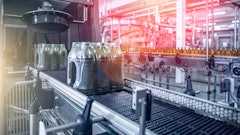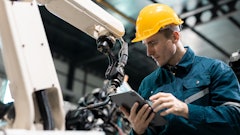
The manufacturing supply chain is being pushed to evolve faster than ever. From global disruptions and workforce shortages to rising costs and consumer demand for speed, the pressure to adapt feels relentless.
Many manufacturers are responding by investing in automation. Even mid-sized operations are seeing the advantages of automation to stay competitive and build more resilient operations.
 Kardex Remstar Americas
Kardex Remstar Americas
Here are six ways automation is driving transformation across the supply chain:
1. Real-time inventory tracking
Are you still relying on inventory guesswork? It may be time to adjust your strategy. Manufacturers are adopting, or scaling, their inventory management software to get real-time visibility into stock levels. This visibility allows teams to respond to changes instantly, reduce costly stockouts, and avoid the pitfalls of overstocking.
To stay competitive, many businesses are starting to incorporate smart warehousing technologies like RFID, barcode scanning, and IoT sensors to enhance data accuracy and product traceability throughout the supply chain.
Modern automated storage and retrieval systems (ASRS) like vertical lift modules (VLMs) and vertical carousel modules (VCMs) integrate seamlessly with ERP systems. As a result, inventory data is no longer buried in spreadsheets. It’s actionable and accessible across the entire organization.
In a survey of 100-plus warehouse leaders, 62.3% listed better inventory control as a top priority going into 2026.
2. Smart labor strategies are taking priority
The manufacturing workforce is stretched thin. According to NAM, there were 449,900 manufacturing job openings in March. Automating routine, physically demanding, or repetitive tasks can help manufacturers to free up their workforce for higher-level responsibilities. But it's important to remember that automation isn’t here to replace jobs. It helps your workforce work smarter.
Instead of manually walking aisles or lifting heavy totes, workers can rely on automation to deliver parts directly to an ergonomic access point.
The result is less physical strain and greater job satisfaction. Facilities using automation often see reduced turnover, higher productivity, and improved safety metrics. Automated vertical storage solutions can bring products directly to the worker at ergonomic waist height. And mobile robotics are creating collaborative warehouse ecosystems.
The best part? Workers tend to embrace these technologies when they make the job safer, easier, and more satisfying. Especially Millennial and Gen Z employees. Companies that implement these tools often see higher retention and improved morale.
3. Flexibility is a competitive advantage
Customization is becoming the norm, not the exception. And not just for mega-warehouses. Manufacturers are expected to manage more frequent product changes, short production runs, and complex order mixes. Static systems can’t keep up with these demands.
That’s why automation is moving toward flexibility. Vertical Buffer Modules (VBMs), for example, support high-speed buffering and automated sequencing.
These systems allow manufacturers to pivot production schedules quickly. This agility is often supported by warehouse execution systems (WES) that dynamically route orders, optimize equipment usage, and synchronize processes across people and machines.
4. Maximizing space without compromising access
Manufacturers are working with tighter footprints, whether due to facility constraints or a push toward leaner operations. Vertical automation systems offer a practical solution by condensing storage into a fraction of the space used by traditional shelving.
A single VLM can recover up to 85% of floor space. Even better, it organizes inventory for faster picking and fewer errors. With floor space reclaimed, companies can repurpose it for higher-value production activities.
Of warehouse leaders using warehouse automation, 78% listed better use of floor space as a top benefit, freeing up entire areas for higher-value production.
5. Kitting and assembly are getting a boost
Accurate kitting is becoming more important, especially as products grow more complex and customized. Manufacturers need the space and ability to gather the right components in the correct sequence.
Kitting with ASRS doesn’t just support workflows. But it can reduce cycle times and improve uptime. This increases throughput while simultaneously maintaining quality control, especially in high-mix, low-volume environments.
Additionally, automated tote shuttles and conveyor systems are helping move kits to the appropriate production zones with minimal human intervention. These solutions are particularly valuable in industries like aerospace, medical devices, and electronics, where precision and compliance are non-negotiable.
6. Smarter supply chains start at the source
The broader supply chain conversation often focuses on what happens outside the facility: transportation, suppliers, and customer logistics. But much of a supply chain’s reliability starts with what happens inside the four walls of the operation.
Forward-thinking manufacturers are automating not just storage and picking but receiving, replenishment, and internal transport. Automated sortation systems quickly organize inbound materials. Scanning tunnels and dimensioning systems collect data without manual input. Autonomous mobile robots (AMRs) deliver materials to the appropriate workstation based on real-time demand signals.
When these systems are integrated with ERP, WMS, and transportation management systems (TMS), the result is a closed-loop supply chain that’s transparent, responsive, and efficient from start to finish.
This internal foundation of automation ensures that every downstream process—from supplier communication to final delivery—is more reliable and scalable.
What’s driving the shift toward automation?
The acceleration of supply chain automation isn’t happening in a vacuum. It’s a direct response to a mix of global pressures and strategic priorities.
For one, persistent labor shortages have left many manufacturers struggling to fill critical roles. This isn’t just a temporary dip—it’s part of a longer-term trend as the skilled trades workforce ages and fewer replacements enter the pipeline. Automation helps close that gap by enabling facilities to maintain productivity levels even with leaner teams.
At the same time, supply chain volatility has become the new normal. From raw material delays to transportation bottlenecks, disruptions can appear anywhere, at any time. Manufacturers are turning to automation to gain better control over what they can influence. Namely, their internal operations. With more agile systems in place, they can respond faster and absorb shocks more effectively.
One of the biggest drivers of automation adoption is changing customer expectations. It doesn’t matter if you sell to distributors or end users. Manufacturers are under enormous pressure to deliver faster, offer more customization, and provide updates throughout the entire process. Automation enables the speed, accuracy, and visibility needed to meet those expectations consistently.
Data-driven decision-making is no longer optional. Automation systems generate valuable insights that help teams optimize workflows and identify continuous improvement opportunities.
Automation is no longer a nice to have. It's becoming central to manufacturing supply chain strategy.
The shift isn't just about speed; it's about building smarter, more adaptable systems that put manufacturers in control of their operations.
For those looking to future-proof their supply chains, the time to automate is now.



















